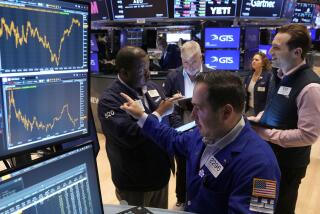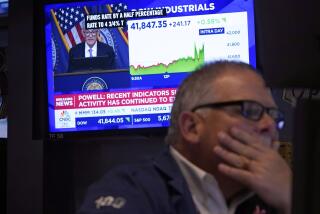Fedâs mixed messages roil markets
WASHINGTON â The Federal Reserveâs unprecedented stimulus efforts are starting to box in the nationâs central banker.
Its bond purchases have helped fuel economic growth since the financial crisis. But Fed policymakers now must figure out how and when to start dialing back the support â and signal that to nervous investors â without derailing the recovery.
Mixed messages from the Fed on Wednesday roiled financial markets, sending the Dow Jones industrial average at one point beyond the 15,500 mark for the first time before swinging about 250 points. It closed down 80.41, or 0.52%, to 15,307.17.
âTheyâre clearly telegraphing a change is coming, but they didnât telegraph which one is coming,â said Larry Palmer, a managing director at Morgan Stanley in Los Angeles.
The stock marketâs sharp reaction to Fed signals underscored how much the stimulus programs have fueled this yearâs rally. Despite Wednesdayâs decline, the Dow is up 17% so far in 2013.
Fed Chairman Ben S. Bernanke added to the uncertainty as he testified before Congress for the first time since February. He said the central bank could start scaling back its stimulative bond-buying program in the next few months, but warned against acting too quickly and harming the still fragile economy.
âItâs clearly the case that weâre not yet where we want to be,â Bernanke told the Joint Economic Committee about the state of the recovery, noting the unemployment rate was still high at 7.5%.
âWe are moving in the right direction,â he said. âBut I donât think we can yet be satisfied given where the labor market is and given that we still have unused capacity in this economy.â
The Dow initially jumped more than 100 points as Bernanke began his testimony by suggesting no change in the stimulus program was imminent. The Dow then dropped sharply when he suggested the Fed soon could start tapering off the $85 billion in monthly bond purchases.
And financial markets rose again as Bernanke said Fed policymakers would need to see significant improvement in the jobs market before they started to scale back the stimulus.
âBernanke basically affirmed that the economy is still too weak and put to rest the issue the Fed is going to taper any time soon,â said Diane Swonk, chief economist at Mesirow Financial. âThe markets like the idea the Fed still has the pedal to the metal and is not going to slow down any time soon.â
But that view shifted again when the Fed released minutes from its April 30-May 1 policy meeting. The minutes showed that some Federal Reserve officials were willing to start ratcheting back the central bankâs stimulus program as early as June if the economic recovery strengthened further.
The news sent the Dow index of 30 blue-chip stocks into negative territory as investors feared the beginning of the end for stimulus efforts that have helped fuel the stock market to historic highs.
All eyes now will be on the governmentâs May unemployment report, to be released in early June, just days before the Fedâs next monetary policy meeting, said Erik Johnson, senior U.S. economist at IHS Global Insight.
If the economy added about 200,000 net jobs, on the heels of Aprilâs 165,000 figure, momentum would build at the Fed to start scaling back its bond purchases as early as September, he said.
The Fedâs aggressive bond buying has helped push long-term interest rates lower, making safer investments like savings accounts and bonds less attractive. That, in turn, has made stocks much more attractive.
Investors are closely watching the Fed to determine when its stimulus policies, including near-zero short-term interest rates, will end, said Jack Ablin, chief investment officer at BMO Private Bank.
âStarting toward the beginning of this year, investors decided to not worry about profits, not concern themselves with the economy, not concern themselves with revenues, but instead just focus on easy money and rising prices,â Ablin said.
Critics have complained that the Fedâs actions could fuel new asset bubbles and increase inflation, which has remained low.
But Bernanke said reversing course too soon could have negative effects.
âA premature tightening of monetary policy could lead interest rates to rise temporarily but would also carry a substantial risk of slowing or ending the economic recovery and causing inflation to fall further,â he said.
The key to reducing the stimulus would be a belief that the jobs market is strong enough to get the unemployment rate back toward a more normal level, Bernanke said.
âWeâre trying to make an assessment of whether or not weâve seen real and sustainable progress in the labor market outlook,â Bernanke said.
âIf we see continued improvement and we have confidence thatâs going to be sustained,â he said, the policymaking Federal Open Market Committee could start scaling back the bond-buying stimulus program âin the next few meetings.â
The committee meets again in mid-June, and monthly through October.
Bernanke said the economy was improving despite the âfiscal head windsâ caused by automatic federal spending cuts and the European recession.
Economic growth has been moderate this year, with spending by consumers and businesses offsetting reductions in government spending, he said. A stronger housing market has helped fuel the growth over the past 12 months.
Though the job market has âshown some improvement recently,â it still âremains weak overall,â Bernanke said.
Palmer said the Fed has to be careful not to cause any shocks to financial markets when it does slow its stimulus efforts.
âThereâs a lot of risks if they donât do it well,â he said.
More to Read
Inside the business of entertainment
The Wide Shot brings you news, analysis and insights on everything from streaming wars to production â and what it all means for the future.
You may occasionally receive promotional content from the Los Angeles Times.










